This is the ultimate African safari. Spend 3 weeks exploring Namibia, Botswana and Zimbabwe, experiencing the wildlife, culture and scenery only Africa can deliver. From marvelling at the Victoria Falls to the breathtaking magnitude of Namibia’s dunes and big game interaction – this tour combines all the comforts of lodge accommodation with an unforgettable safari experience.
Departs: Windhoek, Namibia.
Ends: Victoria Falls, Zimbabwe.
Group size: Guaranteed from 4 guests; 12 guests maximum. *Guaranteed departures with no minimum pax available, please enquire.
Summary
A small-group lodge safari, from Windhoek through Namibia, Botswana & Zimbabwe, ending in Victoria Falls.
Highlights
Windhoek, Sossusvlei, Walvis Bay Lagoon, Swakopmund, Waterberg Plateau National Park, Visit to the Cheetah Conservation Foundation, Etosha National Park, Bushman Experience, Caprivi, Khwai River Region, Makgadikgadi Pans, Chobe National Park, Hwange National Park and Victoria Falls.
Meals
19x Breakfast, 16x Lunch, 15x Dinner. Where included most breakfasts and dinners will be enjoyed in the restaurants of the various accommodation establishments, however on certain nights the guide will provide an authentic meal for the group, which will be enjoyed together in the evening, often around a camp fire. Please advise us of any special dietary requirements in advance.
SAFARI
COST: $4,115 per person sharing, plus local payment of USD 330 (in cash).
SINGLE SUPPLEMENT: $1,005 |
CLICK TO SEE DEPARTURE DATES |
|
DAY 1;
(1 Night)
WINDHOEK, Namibia [Guest House] |
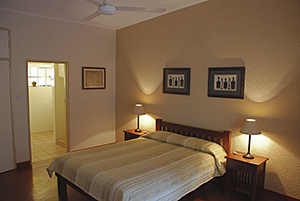 On arrival at Windhoek Airport, you will be met and transferred to your accommodation, Terra Africa Guest House. The rest of the afternoon may be spent at leisure. This evening you will meet your guide and the rest of your group at the lodge at 18h00 for your pre-departure meeting. On arrival at Windhoek Airport, you will be met and transferred to your accommodation, Terra Africa Guest House. The rest of the afternoon may be spent at leisure. This evening you will meet your guide and the rest of your group at the lodge at 18h00 for your pre-departure meeting.
|
Distance / Time: N/A
Overnight: Terra Africa Guest House or similar (rooms with en-suite bathrooms, swimming pool & bar).
Meals: All meals for your own account.
|
DAYS 2 - 3;
(2 Nights)
SOSSUSVLEI, Namibia [Lodge] |
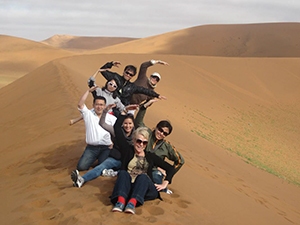 Moving south we make our way towards the Namib Naukluft National Park and our
accommodation for the next two nights, Agama River Camp. The park contains what is
considered to be the oldest desert in the world. The next morning we need to wake up
early to visit the world's highest sand dunes at Sossusvlei and Deadvlei. At sunrise and
sunset these dunes, which can reach heights of over 300 m, are absolutely spectacular
and provide for a fantastic photo opportunity. With luck, there may even be water in the
vlei (lake). We also stop to view the Sesriem Canyon, which was carved millions of years
ago by the Tsauchab River. Moving south we make our way towards the Namib Naukluft National Park and our
accommodation for the next two nights, Agama River Camp. The park contains what is
considered to be the oldest desert in the world. The next morning we need to wake up
early to visit the world's highest sand dunes at Sossusvlei and Deadvlei. At sunrise and
sunset these dunes, which can reach heights of over 300 m, are absolutely spectacular
and provide for a fantastic photo opportunity. With luck, there may even be water in the
vlei (lake). We also stop to view the Sesriem Canyon, which was carved millions of years
ago by the Tsauchab River.
|
Departure Day2: 7am
Distance / Time Day 2: 280 kms
Overnight Day 2: Agama River Camp or similar (rooms with en-suite
bathrooms, swimming pool, bar & restaurant).
Meals Day 2: Breakfast at Terra Africa Guest House or similar, Lunch prepared by the guide, Dinner at Agama River Camp or similar.
Departure Day 3: 6am
Distance / Time Day 3: 230 kms
Overnight Day 3: Agama River Camp or similar (rooms with en-suite bathrooms, swimming pool, bar & restaurant).
Meals Day 3: Breakfast pack from Agama River Camp or similar, Lunch prepared by the guide, Dinner at Agama River Camp or similar. |
DAY 4;
(1 Night)
NAMIB NAUKLUFT NATIONAL PARK TO SKAPOPMUND, Namibia [Lodge] |
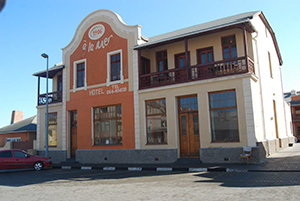 The day is spent driving through the Namib Naukluft National Park on our way to Swakopmund. The Namib-Naukluft Desert is an ancient land with an ageless spirit. It is home to some of the rarest plant and animal species in the world. Sightings of the unique fauna and flora are a must on a Namibian safari. The animals of this harsh landscape include the oryx, springbok and Hartmann’s Mountain Zebra. The day is spent driving through the Namib Naukluft National Park on our way to Swakopmund. The Namib-Naukluft Desert is an ancient land with an ageless spirit. It is home to some of the rarest plant and animal species in the world. Sightings of the unique fauna and flora are a must on a Namibian safari. The animals of this harsh landscape include the oryx, springbok and Hartmann’s Mountain Zebra.
En-route we make a stop in the small town of Walvis Bay where you may spot a variety of birds including flamingo’s in the lagoon. We arrive at the charming coastal town of Swakopmund in the late afternoon, where you will have the opportunity soak up the atmosphere of this quaint, little German town and enjoy its beauty and beaches. Depending on the time of arrival, half day optional activities can be arranged. |
Departure: 7am
Distance / Time: 350 kms
Overnight: Alte Brücke Resort or similar (chalets with en-suite bathrooms).
Meals Day 4: Breakfast at Agama River Camp or similar, Lunch prepared by the guide, Dinner at own expense. |
DAY 5; (1 Night)
WATERBERG PLATEAU, Namibia [Chalets] |
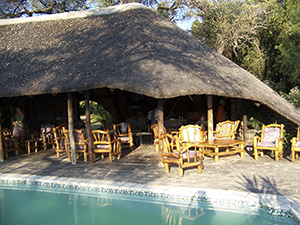 Today we leave the coast behind us and drive to the Waterberg Plateau Park close to
Otjiwarongo. On arrival we go for a short hike in the reserve to view the wildlife on the
mountain. The plateau was first envisaged as a conservation area for eland, Africa's
largest species of antelope. In 1972 it was proclaimed a reserve and has since become a
sanctuary for several rare animals. Today we leave the coast behind us and drive to the Waterberg Plateau Park close to
Otjiwarongo. On arrival we go for a short hike in the reserve to view the wildlife on the
mountain. The plateau was first envisaged as a conservation area for eland, Africa's
largest species of antelope. In 1972 it was proclaimed a reserve and has since become a
sanctuary for several rare animals.
|
Departure: 6am
Distance / Time: 500 kms
Overnight: Waterberg Camp or similar (chalets with en-suite
bathrooms, swimming pool, bar & restaurant).
Meals: Breakfast at Alte Brücke Resort or similar, Lunch prepared by the guide, Dinner prepared by the guide. |
DAY 6;
(1 Night)
WATERBERG TO ETOSHA, Namibia [Lodge] |
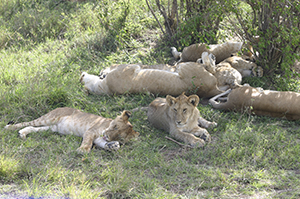 We leave Waterberg National Park and travel via Cheetah Conservation Foundation at Otjiwarongo to Etosha. The CCF is an internationally recognised centre for research and education on cheetahs and their eco-systems. It boasts an extensive visitor’s centre, which encourages tourists to learn more about these beautiful cats and the efforts being made to save them. We continue our journey towards Namibia’s best-known highlight of the north – Etosha National Park. We leave Waterberg National Park and travel via Cheetah Conservation Foundation at Otjiwarongo to Etosha. The CCF is an internationally recognised centre for research and education on cheetahs and their eco-systems. It boasts an extensive visitor’s centre, which encourages tourists to learn more about these beautiful cats and the efforts being made to save them. We continue our journey towards Namibia’s best-known highlight of the north – Etosha National Park.
The first night is spent at our lodge neighbouring the park, situated on an outcrop of dolomite rocks and overlooking a forest of Mopane and white Seringa trees. Spend the afternoon relaxing at the pool, or take a leisurely stroll through the natural bush and gardens. Optional game drives are also available. |
Departure: 8am
Distance / Time: 315 kms
Overnight: Toshari Lodge or similar (rooms with en-suite bathrooms, swimming pool, bar & restaurant).
Meals: Breakfast at Waterberg Camp or similar, Lunch prepared by guide, Dinner at Toshari Lodge.
|
DAYS 7 - 8; (1 Nights)
ETOSHA NATIONAL PARK, Namibia [Chalets] |
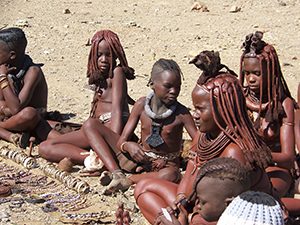 After breakfast we enter the Etosha National Park via the Andersson gate, named after Karl Johan Andersson, one of the first European explorers to come across the Etosha pan, which means “Great White Place” in the Ndonga dialect of the Ovambo tribe. We fill the next two days with game drives in the hopes of spotting lion, leopard, elephant and rhino as well as cheetah, giraffe, zebra and the numerous types of antelope the park has to offer. After breakfast we enter the Etosha National Park via the Andersson gate, named after Karl Johan Andersson, one of the first European explorers to come across the Etosha pan, which means “Great White Place” in the Ndonga dialect of the Ovambo tribe. We fill the next two days with game drives in the hopes of spotting lion, leopard, elephant and rhino as well as cheetah, giraffe, zebra and the numerous types of antelope the park has to offer.
Our nights are spent at the flood-lit waterholes or viewpoints encountering the park’s various nocturnal animals that come to drink. Etosha was declared a National Park in 1907 and it is home to approx. 114 mammal species, 340 bird species, 110 reptile species, 16 amphibian species and, surprisingly, one species of fish. |
Departure Day 7: 7am
Distance / Time Day 7: 230 kms
Overnight Day 7: Namutoni Camp or similar (chalets with en-suite bathrooms, swimming pool, bar & restaurant).
Meals Day 7: Breakfast at Toshari Lodge or similar, Lunch prepared by guide, Dinner at Namutoni Camp or similar.
Departure Day 8: 7am
Distance / Time Day 8: 80 kms
Overnight Day 8: Namutoni Camp or similar (chalets with en-suite
bathrooms, swimming pool, bar & restaurant).
Meals Day 8: Breakfast at Namutoni Camp or similar, Lunch prepared by guide, Dinner at Namutoni Camp or similar. |
DAY 9; (1 Night)
ETOSHA TO OKAVANGO RIVER, Namibia [Lodge] |
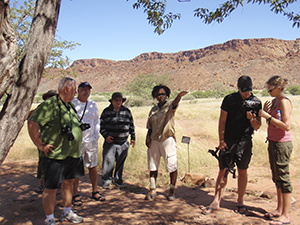 Departing from Etosha we drive into Bushmanland and take a guided visit to the Living Museum of the Ju’Hoansi-San, a local Bushmen community who offer us the opportunity to participate in their daily activities. The Living Museum is an authentic open-air museum where guests can learn about the traditional culture and the original way of living of the San people. Departing from Etosha we drive into Bushmanland and take a guided visit to the Living Museum of the Ju’Hoansi-San, a local Bushmen community who offer us the opportunity to participate in their daily activities. The Living Museum is an authentic open-air museum where guests can learn about the traditional culture and the original way of living of the San people.
A walk is taken in the vicinity of the village with the hunters to search for bush food, watch them prepare snares and ropes and start a fire the Ju/’Hoansi way. After lunch in the shade of the trees, our journey continues to the town of Rundu as we make our way to Kaisosi River Lodge on the banks of the Okavango River. We will arrive in the late afternoon to relax by the pool with a sundowner listening to the sounds of Mother Nature. |
Departure: 8am
Distance / Time: 595 kms
Overnight: Kaisosi River Lodge (rooms with en-suite bathrooms, swimming pool, bar & restaurant).
Meals: Breakfast at Namutoni Camp or similar, Lunch prepared by the guide, Dinner at Kaisosi River Lodge or similar. |
DAY 10; (1 Night)
MAHANGU, Namibia [Lodge] |
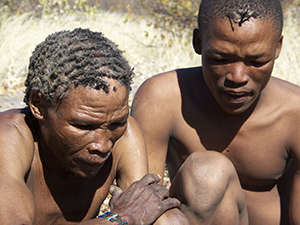 This morning we travel eastwards onto our camp in the western Caprivi region, Mahangu Lodge. Before departure however, there will be time for optional activities such as an early morning boat cruise at the lodge or a visit to the Mbunza Living Museum, a traditional cultural school and communal business for the local Kavango people. We then continue to Mahangu, meaning ‘food of the local people’, which is situated next to the Okavango River. This morning we travel eastwards onto our camp in the western Caprivi region, Mahangu Lodge. Before departure however, there will be time for optional activities such as an early morning boat cruise at the lodge or a visit to the Mbunza Living Museum, a traditional cultural school and communal business for the local Kavango people. We then continue to Mahangu, meaning ‘food of the local people’, which is situated next to the Okavango River.
Enjoy an afternoon game drive in the Greater Bwabwata National Park, which extends from the Kavango River in the west to the Kwando River in the east and incorporates the Mahangu Game Reserve. Elephant, roan, kudu and buffalo are amongst the animals likely to be seen as well as prolific birdlife. |
Departure: 8am
Distance / Time: 270 kms
Overnight: Mahangu Lodge or similar (rooms with en-suite
bathrooms, swimming pool, bar & restaurant).
Meals: Breakfast at Roy's Rest Camp or similar, Lunch pack from Kaisosi River Lodge, Dinner at Mahangu Lodge or similar. |
DAY 11; (1 Night)
MAUN, Botswana [Chalets] |
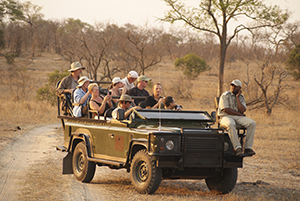 We leave the Caprivi and travel south to Maun, the gateway to the Okavango Delta and Moremi Game Reserve. The name Maun is derived from the San word “maung”, which means “the place of short reeds”. The afternoon is yours to spend at leisure, either relaxing next to the pool at the lodge or if you are keen for some excitement, why not book a scenic flight over the Okavango Delta. We leave the Caprivi and travel south to Maun, the gateway to the Okavango Delta and Moremi Game Reserve. The name Maun is derived from the San word “maung”, which means “the place of short reeds”. The afternoon is yours to spend at leisure, either relaxing next to the pool at the lodge or if you are keen for some excitement, why not book a scenic flight over the Okavango Delta.
|
Departure: 7am
Distance / Time: 430 kms
Overnight: Thamalakane River Lodge or similar (chalets with en-suite
bathrooms, swimming pool, bar & restaurant).
Meals: Breakfast at Mahangu Lodge or similar, Lunch pack from Mahangu Lodge, Dinner at your own account. |
DAY 12; (1 Night)
MAUN TO KHWAI RIVER, Botswana [Tented Camp] |
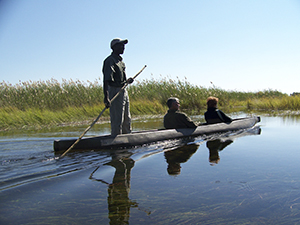 After breakfast we will be picked up by our local Botswana guides and take a short drive to the mokoro station. From here, we will float in these traditional dug-out canoes through the thick vegetation of the Okavango Delta discovering a variety of birds and wildlife. Unlike other deltas, it flows into the Kalahari Desert without ever reaching the coast. After this spectacular excursion, we make our way to our camp, which is situated in the Khwai River region. After breakfast we will be picked up by our local Botswana guides and take a short drive to the mokoro station. From here, we will float in these traditional dug-out canoes through the thick vegetation of the Okavango Delta discovering a variety of birds and wildlife. Unlike other deltas, it flows into the Kalahari Desert without ever reaching the coast. After this spectacular excursion, we make our way to our camp, which is situated in the Khwai River region.
Once settled into our camp, we will enjoy dinner and embark on a night game drive in the private concession – a fantastic opportunity to spot some nocturnal animals that are more difficult to encounter during the day. |
Departure: 8am
Distance / Time: 100 kms
Overnight: Khwai Bedouin Camp or similar (semi-permanent tented camp with en-suite bathrooms). Please note that there is no electricity at the camp.
Meals: Breakfast at Thamalakane River Lodge or similar, Lunch at Thamalakane River Lodge, Dinner at Khwai Bedouin Camp or similar. |
DAY 13; (1 Night)
KHWAI RIVER, Botswana [Tented Camp] |
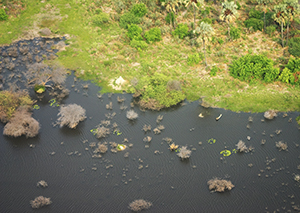 We have the opportunity to spend the day on game drives. In our open 4x4 vehicle we will explore the Khwai River region area on morning and afternoon game drives hopefully spotting a variety of game that frequent this region. This large area is renowned for its concentration of mammals and it is not unusual to see many different types of wildlife during just one game drive. We have the opportunity to spend the day on game drives. In our open 4x4 vehicle we will explore the Khwai River region area on morning and afternoon game drives hopefully spotting a variety of game that frequent this region. This large area is renowned for its concentration of mammals and it is not unusual to see many different types of wildlife during just one game drive.
Game viewing is seasonal; depending on the time of the year you may see different species in different areas. The best time for game viewing is the end of the dry season or spring from August to November. During this season, in order for us to offer the best game viewing possible, extra driving may be required due to the animals migrating closer to the river. In the summer, birdlife can also be viewed in abundance with exceptional sightings of wildfowl and raptors. |
Departure: 7am
Distance / Time: 150kms
Overnight: Khwai Bedouin Camp or similar (semi-permanent tented camp with en-suite bathrooms).
Meals: Breakfast Lunch and
Dinner at Khwai Bedouin Camp or similar. |
DAY 14; (1 Night)
KHWAI TO NATA, Botswana [Tented Lodge] |
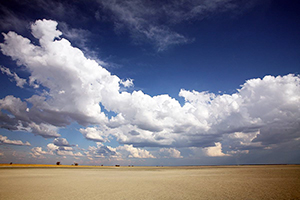 We leave the bush behind and travel east towards the Makgadikgadi Pans, once a large river fed lake, however the pans are now saline and empty. In the afternoon we visit the Nata Bird Sanctuary, where we get the opportunity to enjoy the magnificent view over the Sowa pan, which is part of the Greater Makgadikgadi Pans. We leave the bush behind and travel east towards the Makgadikgadi Pans, once a large river fed lake, however the pans are now saline and empty. In the afternoon we visit the Nata Bird Sanctuary, where we get the opportunity to enjoy the magnificent view over the Sowa pan, which is part of the Greater Makgadikgadi Pans.
Please note a visit to the pans is subject to the road conditions and water levels as well as time constraints. |
Departure: 8am
Distance / Time: 420 kms
Overnight: Nata Lodge or similar (Safari tent with en-suite bathrooms,
swimming pool, bar & restaurant).
Meals Day 14: Breakfast at Khwai Bedouin Camp or similar,
Lunch prepared by the guide,
Dinner at Nata Lodge or similar. |
DAYS 15 - 16; (2 Nights)
NATA TO CHOBE, Botswana [Tented Lodge] |
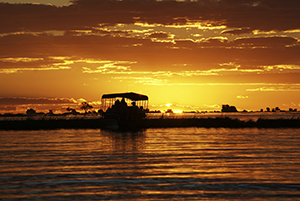 This morning we head north to Kasane, the gateway to the Chobe National Park. Chobe, which is the second largest national park in Botswana and covers 10,566 square km, has one of the greatest concentrations of elephant found on the African continent. The afternoon is at leisure to partake in a number of optional activities or to relax by the pool. This morning we head north to Kasane, the gateway to the Chobe National Park. Chobe, which is the second largest national park in Botswana and covers 10,566 square km, has one of the greatest concentrations of elephant found on the African continent. The afternoon is at leisure to partake in a number of optional activities or to relax by the pool.
The next day you will get to see the wildlife of the Chobe National Park on a morning game drive, with the hope of spotting big game up close and also the possibility of an encounter with one of the large predators. In the afternoon we go on a cruise on the Chobe River, a truly unforgettable experience and one of the best ways to view the animals as they come down to drink, as well as the spectacular African sunset. |
Departure: 6am
Distance / Time: 320 kms
Overnight: Chobe Safari Lodge or similar (rooms with en-suite bathrooms, swimming pool, bar & restaurant).
Meals 15: Breakfast at Nata Lodge or similar,
Lunch prepared by the guide,
Dinner at Chobe Safari Lodge or similar.
Meals 16: Breakfast at Chobe Safari Lodge or similar,
Lunch at your own account,
Dinner at Chobe Safari Lodge or similar. |
DAYS 17 - 18; (2 Nights)
CHOBE TO HWANGE NATIONAL PARK, Zimbabwe [Tented Chalets] |
 we make our way across the border into Zimbabwe and onto Hwange National Park where we spend the next two nights. Hwange National Park is one of Africa's finest havens for wildlife and is home to vast herds of elephant, buffalo, and zebra and has a very large concentration of giraffe. It is also home to many predators and endangered species plus varied birdlife. A full day game drive is included on the park on the second day. we make our way across the border into Zimbabwe and onto Hwange National Park where we spend the next two nights. Hwange National Park is one of Africa's finest havens for wildlife and is home to vast herds of elephant, buffalo, and zebra and has a very large concentration of giraffe. It is also home to many predators and endangered species plus varied birdlife. A full day game drive is included on the park on the second day.
|
Departure: 8am
Distance / Time: 265 kms
Overnight: Sable Sands or similar (tented chalets with en-suite bathroom, swimming pool & bar area).
Meals Day 17: Breakfast at Chobe Safari Lodge or similar,
Lunch prepared by the guide,
Dinner at Sable Sands or similar.
Meals Day 18: Breakfast at Sable Sands or similar,
Lunch pack from Sable Sands or similar,
Dinner at Sable Sands or similar. |
DAY 19; (1 Night)
VICTORIA FALLS, Zimbabwe [Lodge] |
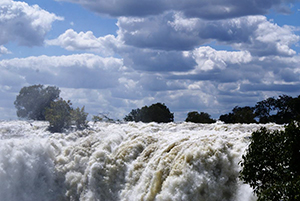 Continuing our trip, we turn northwards to Victoria Falls in Zimbabwe. Your guide will take you on a tour of the mighty Victoria Falls, known by the local Kololo tribe as Mosi oa Tunya - “the smoke that thunders”. The rest of the day may be spent at leisure or partaking in one of the many optional activities on offer. Continuing our trip, we turn northwards to Victoria Falls in Zimbabwe. Your guide will take you on a tour of the mighty Victoria Falls, known by the local Kololo tribe as Mosi oa Tunya - “the smoke that thunders”. The rest of the day may be spent at leisure or partaking in one of the many optional activities on offer.
|
Departure: 9am
Distance / Time: 190 kms
Overnight: Ilala Lodge similar (rooms with en-suite bathrooms, swimming pool, bar & restaurant.
Meals: Breakfast at Sable Sands or similar,
Lunch at your own account,
Dinner at your own account. |
DAY 20;
VICTORIA FALLS, Zimbabwe [TOUR ENDS] |
Our safari ends after breakfast. You will be transferred to Victoria Falls Airport in time for your departure flight. We hope to welcome you again one day on another of our African adventures. |
Departure: N/A
Distance / Time: N/A
Overnight: N/A
Meals: Breakfast at Ilala Lodge or similar.
|
Note: The accommodation specified in the itinerary is a guide only and is subject to availability. Alternatives will be nearby and of a similar standard.
 Top Top
CLICK TO SEE DEPARTURE DATES
Included
Accommodation as mentioned in the itinerary, all transport in fully kitted 4x4 safari vehicle, game drives as mentioned, meals and activities as mentioned in itinerary, park entrance fees, experienced local guide.
Excluded
Travel insurance, flights, pre and post tour accommodation, optional activities, all drinks, telephone calls, gratuities, curios and all personal expenses.
Departure
The Great Trans-African Lodge Safari departs from Terra Africa Guest House, Windhoek.
Please note that the daily departure times are a guideline only and are subject to change due to seasonal variations, as well as unforeseen circumstances. The final decision rests with your guide who will advise you at what time you will be departing each day.
On the evening of day 1, there will be a meeting presented by your guide, at 18h00, at your lodge. It is imperative that all clients attend this meeting so as not to miss out on any critical information. Whilst it is our every intention to adhere to the above mentioned itinerary, there may on occasion be a necessity to make alterations in order to make the tour more enjoyable or practical. Therefore please treat the itinerary as a guide only.
Transport
The safari uses fully equipped 12-seater 4x4 safari vehicles or other appropriate vehicles with comfortable seating, large windows for game viewing, a music and PA system and air-conditioning. All luggage, besides hand luggage and photo equipment, is carried on the vehicle or trailer roof racks to ensure maximum comfort in the vehicle. Some game drives may be conducted in open-sided safari vehicles. For transfers between Kasane and Victoria Falls or Hwange and Victoria Falls (or vice versa), 2x4 vehicles may be utilized.
Travelling Times and Distances
All travelling times are affected by road conditions, border crossings, detours and weather conditions, therefore on certain days travelling times may be longer than anticipated especially where there is a lot of distance to be covered. Please keep in mind that the time it takes to travel 100 km in your home country is not equivalent to the time it takes to travel 100 km on African roads, therefore we encourage you to sit back and enjoy the spectacular scenery Africa has to offer. Where possible additional stops will be made to ensure your travelling comfort at all times.
Accommodation
We make use of mid-range typical African standard lodge accommodation. Accommodation is situated either in national parks, on the banks of a river, or in other places of interest. The accommodation will be a mix of lodges, chalets and tented camps with en-suite bathrooms. Some properties are equipped with swimming pools, restaurants and/or bar areas.
Local Payment
A local payment is required on your safari and will be collected by your guide on the day of departure. The local payment is part of the overall tour cost and is used to pay some of the day to day operational costs that are incurred while we are on the road. We try to prepay as many of the costs as possible however in some cases cash payment on arrival is the only option as some of the attractions we visit on safari only accept cash. Examples include park fees at most of the national parks, a few accommodations or camp sites and any local food markets we visit to stock up on fresh produce during the tour as well as local guides.
Visas
The onus is on the client to organize all visas required to visit Namibia, Botswana and Zimbabwe prior to departure.
Information on Areas Visited
BOTSWANA
The San were among the first human inhabitants of this region before the Setswana migrated southwards and slowly occupied the region from the 16th century onwards, until early in the 19th century. By mid-century missionaries arrived, including David Livingstone and Robert Moffat, and by 1885 the territory was a British protectorate. Botswana gained its independence in 1966 and has been the most stable democracy in Africa. The first president ruled from 1966 until his death in 1980, the second till 1994 (re-elected twice, then resigned) and the third from 1998.
The country has a strong currency with one of the highest per capita incomes in Africa,
maintains a neutral international political stance. It is heavily reliant on mining (especially
diamonds) & tourism and maintains close ties with its neighbor South Africa, an economic
powerhouse for the region.
Wildlife is abundant in Botswana and includes lion, giraffe, leopard, antelope, elephant, crocodile and ostriches. Botswana is semiarid and has an average annual (summer)
rainfall of 640 mm (about 25 in) in the north to less than 230 mm (less than 9 in) in the
Kalahari. Drought is therefore not uncommon and the vegetation is mostly savannah.
Geographically Botswana is relatively flat (the average elevation of about 1000 m) and
can be viewed (for all intents and purposes) as three major regions as follows:
Chobe National Park in the north, another outstanding wilderness area of enormous
diversity – lion and elephant can be viewed from river cruises or 4x4 game drives.
The Okavango Delta is a vast marshland and one of the largest inland river deltas in the
world – 15 000 km2 of wilderness and prime safari area. The Kalahari Desert in the central
and southwestern regions occupies over half the land area of Botswana. It is a mystical,
harsh and unspoiled landmass. The saltpans of north-central Botswana and the Tuli block in the far eastern corner of
Botswana are also areas of significance.
Chobe National Park
Chobe is approx. 11 000 km2 of wilderness area watered by the Chobe & Savuti Rivers
and thus attracting huge concentrations of game. This includes lion and some of the
highest concentration of elephant in Africa – an estimated population of around 25 000
in winter. Game viewing is renowned and in the Northern areas near Kasane, both the
riverboat game viewing experience and the 4x4 vehicle option are popular.
In addition the spectacular annual summer migrations of plains game, especially Zebra,
is a highlight, as well Giraffe, Warthog and numerous antelope including Sable, Roan,
Oribi, Reedbuck, Lechwe and the colourful Chobe Bushbuck.
Bird watching opportunities in Chobe are ample and include some 350 species including
the awesome African Fish Eagle, the rare Pell's Fishing Owl, saddle-billed storks, long-toed
Plovers, pink-backed Pelicans, African Skimmers, Bradfield's Hornbills and Carmine Beeeaters.
In addition, the sunsets are spectacular.
Makgadikgadi Pans
The lesser-known Makgadikgadi Pans National Park is situated between Maun and Nata
in Botswana. The shimmering saltpans of Makgadikgadi are the size of Switzerland and
most of the time appear as a glaring, white, endless plain. When the rain comes a
dramatic change takes place as the pans come to life with frantically feeding water
birds and great herds of game. The best time to visit this area to coincide with the
migration is from December to March or in the dry season from April to October when
the pans are dry.
The park contains four main vegetation types: riverine woodland, scrubland, pure
grassland and saltpans. The pans support palm groves and peculiar looking Baobab
trees whose branches look more like roots, giving rise to the name 'upside down tree'.
These are interspersed with short spiky yellow grass found on rises between the pans,
known as 'prickly salt grass'. This grass is extremely saline resistant to the extent that salt
crystals can sometimes be seen on the leaves. The interior of the reserve comprises scrub
and grassland with a few 'islands' of Real Fan Palms and Camel-thorn Acacia.
From April to November game such as Springbok, Gemsbok, Wildebeest and Zebra
move slowly from the pans area in the south east of the park, to the Boteti River in the
west. During this migration animals accumulate in their thousands. The heavily wooded
areas beside the river also contain shy antelopes like Duiker and Bushbuck.
Maun
Maun is the gateway to the Okavango Delta and one of the best safari experiences you
will have. Countless safari and air-charter operators have offices here, thus it is busy with
people coming and going especially around the airport. The best time to go is during the
winter months from May to October when there is little or no rainfall and the days are
warm and cloudless. Nights can be cold though so take a jacket. November to April can
be very hot, with most of the rainfall between December and February.
Maun has developed rapidly from a rural frontier town and has spread along the wide
Thamalakane River. It now boasts good shopping centers, hotels and lodges as well as
car and 4x4 vehicle hire. However, it still retains a rural atmosphere and local tribesmen
still bring their cattle here to sell and you could see antelopes grazing the riverbanks.
Okavango Delta
The Okavango Delta in northern Botswana (near Maun) incorporates the Moremi Game
Reserve and is a unique wildlife paradise - one of the finest in the world. It is also one of
the largest inland river deltas in the world. This unsurpassed natural environment is a maze
of waterways, islands and reed banks creating a perfect habitat for lion, elephant,
leopard, buffalo, giraffe, hyena, wild dog, kudu, impala, roan, zebra, lechwe, hippo and
crocodile, amongst others. There are approx 440 bird species in the delta and fish
species are also abundant, including tiger fish, sharp-toothed catfish, barbell and bream.
Travel through the swamps and surrounding areas is generally done by open 4x4 game
viewing vehicle or a peaceful meander in a 'Mokoro', a flat-bottomed dugout canoe.
The Delta is hot throughout the year with temperatures ranging from approx 14°C in
January to 24°C in July. Rainfall averages 525 mm annually, but varies greatly from year
to year. Water levels and flooding reach a maximum between March and July, after
rains at the source and the usual 15 000 km2 can expand to approximately 22 000 km2 in
high-rainfall years.
NAMIBIA
'Namibia' means 'open plains' in the ancient Hottentots language. It is a sought after
tourist destination defined by endless sunshine, scenic beauty and unusual and
contrasting topography. Namibia is sandwiched between two deserts - the Namib
Desert, said to be the oldest in the world, on its western coastline and the Kalahari Desert
in the eastern interior. Northern Namibia features the great Etosha National Park, with the
countries largest concentration of game and in the south the majestic Fish River Canyon
plunges 550 m and extends for 160 km. Between these four highlights lies over 820 000
km2 (the size of France & Britain combined) of contrasting scenery.
The world's highest dunes are found in haunting scenery inspiring somber reflection. Prehistoric
rock art, the ancient fossil plant, Welwitschia mirabilis and fossilized dinosaur
footprints are preserved in the ancient, rocky mountain ranges.
Many of the features of this country are of particular scientific interest and attract
scientists from all over the world.
Namibia is the first country in the world to include protection of the environment and
sustainable utilization of wildlife in its constitution. About 15,5% of the country has been
set-aside as national parks. In these areas, rare and endangered species of animals, birds and plant life are preserved and protected. They serve as a living reminder to us all, and to the generations of the future, of how it once was in Africa.
Damaraland
North of the main road of Swakopmund and South of Kaokoland extends Damaraland,
one of the most beautiful regions in Namibia. Open plains, grasslands, and distant
mountains as well as a petrified forest of 260-millionn year old trees create the
landscape. Damaraland habits Namibia's highest mountain, the Brandberg with its
famous "white lady" painting and the most precious open-air rock art gallery in the world
at Twyfelfontein. Game, which can be found in this area, is the desert elephant, black
rhino, ostrich and springbok.
Etosha
Consisting of over 22 000 km2 of saline desert, savannah and woodlands, the Etosha
National Park is one of the largest game reserves in Africa and one of the major
sanctuaries for wildlife. Its definitive feature is the Etosha Pan, a vast shallow depression of
about 5 000 km2. This great, white expanse locals call 'great place of dry water', often
shimmers with mirages and herds of game can be seen within this eerie setting. There
are 144 mammal species in the park, including elephant, giraffe, blue wildebeest and
black rhino, predators such as lion, cheetah, leopard, wildcat, hyena and jackal. The
black rhino population of 300 is one of the few growing populations in the world and the
local elephants are reputed to be the largest in Africa - the tallest standing at 4m at the
shoulder. Their tusks however are relatively small due to genetic defects and mineral
deficiencies in their diet. The majestic eland, the tiny, shy Damara dik-dik (45 cm high)
and the striking gemsbok, with its dramatic black and white markings are common. Bird
life is prolific and some 340 species have been identified, including Namibia's national
bird, the vividly coloured crimson-breasted shrike. During the more rainy seasons Etosha is
also one of the most important breeding grounds for flamingos.
Etosha is also known for its expert game management and attentive protection of the
unspoiled environment.
Swakopmund
A true oasis and respite from the solemn desert and its monotonous heat. A seaside
holiday resort full of old-world charm and modern amenities, from the quaint German
colonial influences to a funky Internet café. The tranquil setting includes promenades,
palm trees and beautifully tended public gardens, the Swakopmund museum (covering
natural history, mineralogy, botany, historical and ethnological aspects), the National
Marine & Research Centre, an aquarium, a public library, an Olympic sized, heated
indoor swimming pool and a grassed golf course in a desert setting. This 'middle of the
desert' feel is one of its attractions – one can enjoy the wild expanse of the adjacent
desert and sea and yet be within easy reach of the creature comforts of Swakopmund's
hotels, restaurants, bars and a much-needed laundries! There is plenty to see and do
and activities include quad biking, sand boarding, rock & surf fishing and skydiving.
Sossusvlei
The visual spectacular in the Sossusvlei area is unsurpassed. Amongst the continuous
towering dunes as far as the eye can see is arguably the highlight of the Namib Desert,
the Sossusvlei, an enormous clay-pan, enclosed by dunes. After a heavy rainfall, rare in
this area, the vlei fills with water and, as the clay layers are virtually impermeable to
water, a turquoise lake remains for quite some time.
The dunes and their rich tints vary from pale apricot to vivid reds and oranges, and
contrast vividly with the dazzling white surfaces of the white clay pans, or lakes, below.
During the rainy season one of the larger of these pans creates a haven for water birds,
often including flamingos. Even during the dry season, Oryx, springbok and ostriches can
be seen feeding off the sparse vegetation along the watercourses.
The dunes of the Namib Desert developed over a period of many millions of years and
are shaped by strong-multi-directional winds. It is thought that the vast quantities of sand
were carried into the Atlantic Ocean by the Orange River. The surf pushed the sand
back onto land and coastal dunes formed. Dunes have subsequently shifted inland and
northwards. Wind continuously re-stacks the sand of the huge shifting dunes of the Namib
Desert. It tirelessly forces the grains of sand on the flat windward slope upwards to the
crest of the dune. Here they fall down in the wind shade. The leeward slope, therefore, is
always considerably steeper than the windward side.
Waterberg Plateau Park
The Waterberg Plateau Park can be found 280 km north of Windhoek and stands out of
the thorn savannah with its lush vegetation at the lower slopes. This 20 km wide and 50
km long table mountain massif consists of porous sandstone which let to surface water
and springs at the foot of the mountain, from which it got its name.
Historic interest people may already have heard about the name Waterberg. It was the
area where in 1904 the devastating battle between the Hereros and the German
Colonial soldiers took place. But the only thing, which remembers at this tragic event, is a
military graveyard near the park.
Nowadays the Waterberg Plateau is a sanctuary for many endangered species. It habits
among others black and white rhinos, buffalos, various types of antelopes, giraffes,
leopards, cheetahs, hyenas, jackals, wild dogs and the only herd of Cape vulture in
Namibia. Beside the big mammals several enchanting small ones can be seen as well,
such as the Damara Dik-Dik or lesser bush babies. The plateau is said to be one of the
most interesting geological sites in Namibia and disposes over a rich variety of flowers,
trees and shrubs. You can experience karees, lead wood and buffalo-thorn trees and
weeping wattle with its yellow flowers appearing in the spring. Other attractions are the
dinosaur tracks and petrified dunes. Unfortunately visitors are not allowed to explore the
park by their own vehicles, but there are regular daily excursions organized by the park.
The nights can be spent in a beautiful rest camp, which can accommodate more than
200 people, or at a camping site.
Western Caprivi
A part of the Western Caprivi previously known as the Golden Triangle is a pristine
wilderness area, practically untouched by any. The area was formerly under government
jurisdiction – a 'no man's land' so wild that both private landowners and even nature
conservation officials had no authority until the early-nineties. The land was finally
handed over to nature conservation officials who now have prominent presence in the
area.
ZIMBABWE
This is a country blessed with great natural beauty, game reserves and mineral wealth.
The diverse landscape changes from mountainous to wilderness to typical Bushveld. The
country is also home to large animals and a large bird population. Zimbabwe is a country
located in the southern part of the continent of Africa, between the Victoria Falls,
Zambezi river, Kariba Dam and the Limpopo river. Zimbabwe is bordered by South Africa
to the south, Botswana to the west, Zambia to the north and Mozambique to the east.
Victoria Falls
'So lovely it must have been gazed upon by angels in their flight' said David Livingstone of the supreme Mosi-oa-Tunya ('The smoke that thunders'). This legendary traveler first
saw the Falls from the Zambian side and his memory is enshrined in the nearby town of
Livingstone. The views from the Zimbabwean & Zambian side are quite different, varying
dramatically depending on the season and water flow.
The Falls are over a mile in length and boast the largest curtain of water in the world -
over 500 million liters or water per minute go over the falls and drop 100 m at Rainbow
Falls on the Zambian side. Not surprisingly is it the seventh wonder of the world and fast
becoming one of the top adventure destinations in the world.
The river is divided into a series of braided channels that descend in many separate falls.
Below the Falls the river enters a narrow series of gorges, which represent locations
successively occupied by the falls earlier in their history. Since the uplifting of the
Makgadikgadi Pan area some two million years ago, the Zambezi River has been cutting
through the basalt base rock, exploiting weak fissures, and forming a series of retreating
gorges. Seven previous waterfalls occupied the seven gorges below the present falls,
and Devil's Cataract in Zimbabwe is where the next cut back will form a new waterfall
that will eventually leave the present falls lip high above the river in the gorge below.
Hwange National Park
Hwange National Park is one of Africa's finest havens for wildlife and is home to vast
herds of elephant, buffalo, and zebra and has a very large concentration of giraffe. It is
also home to many predators and endangered species plus very large and varied
birdlife.
The park is situated on the main road between Bulawayo and the world famous Victoria
Falls. Hwange National Park covers just over 14 600 square kilometres. The Park carries
105 mammal species, including 19 large herbivores and eight large carnivores. Elephant
make up the largest proportion of the biomass.
All Zimbabwe's specially protected animals are to be found in Hwange and it is the only
protected area where gemsbok and brown hyena occur in reasonable numbers. The
population of wild dog to be found in Hwange is thought to be of one of the largest
surviving groups in Africa today.
The landscape includes desert sand to sparse woodland as well as grasslands and
granite outcrops. Due to the lack of water, man-made waterholes were introduced to
sustain the animals through the dry season. The park has an interesting variety of
landscapes with one part running alongside the North-eastern end of the Kalahari
Desert. The south is sandy with extensive forests and open grassland. A feature of the area is ancient fossil dunes - ancient sand dunes held together by vegetation.
 Top Top
Please contact us for dates.
 Top Top  Return to Value Safari Packages Return to Value Safari Packages
|